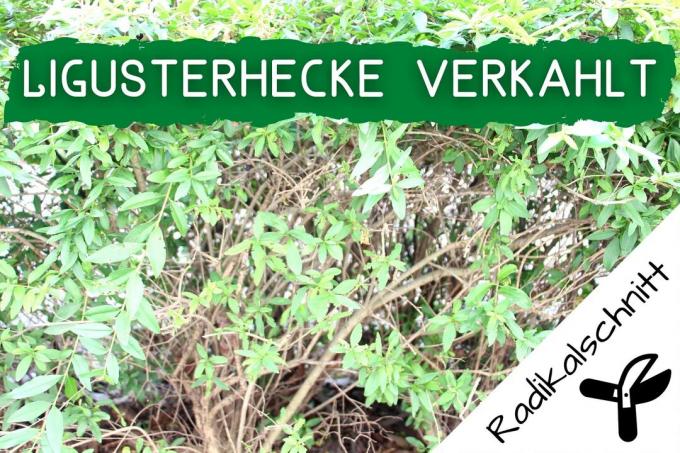
Table of Contents
- Appropriate cutting tool
- Best time
- Two cutting variants
- Fertilize and water
- prevention
- frequently asked Questions
the liguster (Ligustrum) forms a dense privacy screen due to the numerous leaves. However, if it sheds its lower leaves, it is gone. With our instructions, you can optimally cut the bare privet hedge and breathe new life into it.
In a nutshell
- Privet hedges usually become bare due to carelessness when cutting
- Cause: poor lighting conditions
- Privet begins to shed leaves at the bottom
- Radical pruning stimulates new growth
Appropriate cutting tool
Before you start to cut the bare privet hedge, you need to provide suitable cutting tools. In order to avoid frayed, poorly healing cuts and the transmission of pathogens, it should therefore meet the following requirements:
- sharp
- clean, previously disinfected
- straight cutting possible
- Ideally suited: pruning shears, pruning shears, electric hedge trimmers
Tip: For disinfection, disinfectant sprays or wipes with at least 70 percent isopropanol are the easiest and most reliable to use. Alternatively, alcohol also has a disinfecting effect.
Best time
In order for the privet hedge to swing out strongly after cutting, the best time for the radical cut is in early spring. Then the growing season is approaching and the olive tree produces plenty of the energy needed for budding. In addition, a tag should be chosen for the pruning that has certain properties:
- Dryness to minimize risk of infection
- Cloudy because sun can cause burns and yellow leaves
- frost-free, due to increased risk of cold damage

Notice: A radical cut, in which the privet loses a lot of volume and height, is between the 1. March and 30. September prohibited by law. Therefore, the cut should be made early.
Two cutting variants
The pruning to stimulate new growth can be carried out in two different variations, which can also be used in combination.
Radical pruning of upper shoots
If a privet hedge is bare, there is usually not enough light reaching the interior of the plant and the lower part of the plant. This means that photosynthesis cannot take place and the plant sheds "useless" foliage. The solution is a pruning, which allows light to shine on the plant parts below. To do this, the upper shoots must be removed.
This pruning technique precedes the second pruning technique if necessary. If a privet hedge is only minimally bare at the bottom, it is usually sufficient to remove only the upper shoots. The following instructions describe the procedure:
- Shorten the upper shoots by at least a third
- Cut off up to two-thirds of the old wood if there is a lot of bare wood
- remove dried shoots close to the base (especially inside the hedge)

Put on stick
If the privet hedge is already heavily bare, further shoots must be cut off radically. This affects the side shoots that come after the top shoots have been removed. Because they are severely trimmed almost to the cane, this pruning technique is referred to as "cutting to cane." The instructions show how this works:
- Cut off all side shoots about three centimeters in front of the trunk (used for branching)
- Also remove shoots that are not dead
- first new shoots at higher temperatures
- then keep the width of the upper part of the shoot narrow until the side shoots have reached the same width
- Do not correct growth height until regular trimming
Fertilize and water
If a privet hedge has been radically shortened, the nutrient and water requirements increase significantly. Especially for a dense foliage, help with fertilization is now appropriate. The following should be taken into account:
- Apply green plant fertilizer immediately after pruning
- Repeat every two weeks through August
- high nitrogen content promotes leaf growth
- alternatively with mature compost or horn shavings fertilize
- water generously after pruning and fertilizing
- avoid drying out of the soil later on

prevention
So that privet hedges do not have to be radically shortened more often, intelligent measures should be taken to prevent balding. This can be achieved in the following way:
- Carry out light back and/or topiary cuts twice a year
- best times between February and May as well as in August
- avoid square or rectangular shapes (shading in the lower area)
- Cut side shoots diagonally from bottom to top
frequently asked Questions
Yes, but they usually don't bare all the way to the top, so cutting back close to the ground isn't necessary. This is usually only done when privet hedges are very weak. Diseases and pest infestations are usually the causes of a strong weakening. But care errors can also be reasons for a radical pruning down to the ground.
That depends on the location and, above all, on the respective planting distances. In general, spherical shapes actually tend to be bare more because the circumference is widest in the middle and the foliage “tapers” towards the bottom. Here it is important that light and sun reach the leaves from all directions. This requires a single planting. Spherical privets are therefore less or not at all suitable as a dense hedge.
Theoretically yes, but autumn weather conditions mean an increased risk of infection and cold damage from possible frost after pruning. In addition, there is a delayed new growth. It is therefore advisable to let them go through the winter bare and cut back in February at the earliest.

